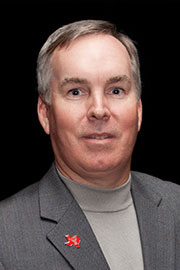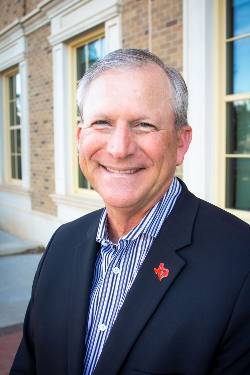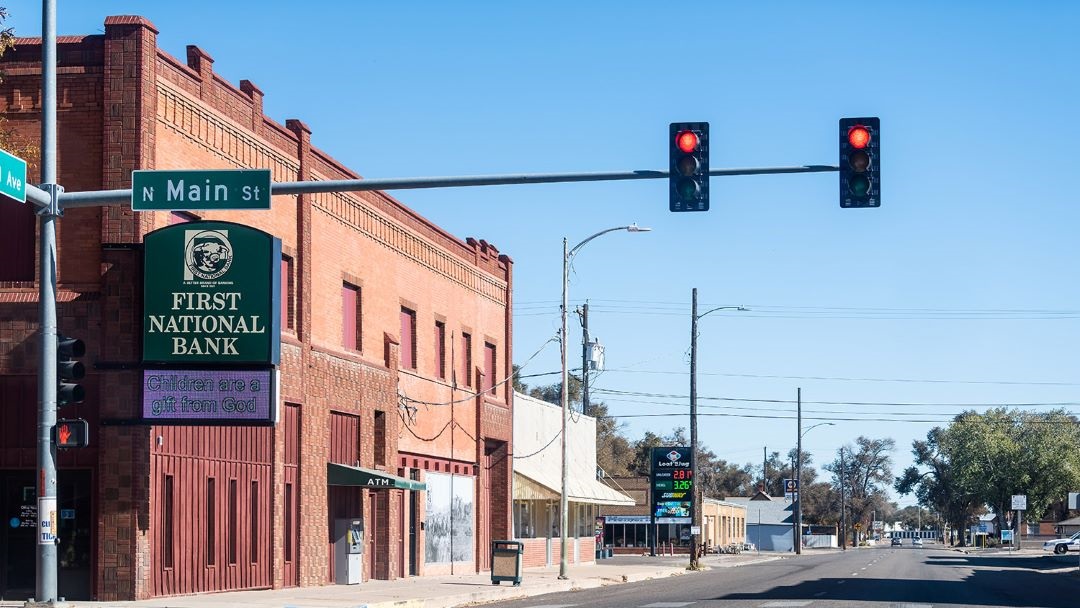A new analysis of the CARES Act’s Paycheck Protection Program highlights the importance of “relationship banks” in smaller communities.
When Drew B. Winters went to his credit union for a car loan, it wasn't exactly a typical transaction.

"The CEO of the credit union was in my first class I taught here," said Winters, a professor and the Lucille and Raymond Pickering Chair in Finance in Texas Tech University's Jerry S. Rawls College of Business. "The lender filling out the paperwork said, 'I've got to go get approval for this.' He walks out and runs into the CEO, who points to me, signs the document and we were done."
Winters isn't dropping names – he's emphasizing the importance of community banks, the typically smaller financial institutions that still have one-on-one, personal relationships with their customers. In the age of the coronavirus pandemic, these banks have played a key role in the Paycheck Protection Program (PPP), giving out loans to help businesses keep their workers employed.
But the number of community banks is dwindling, and a growing number of financial experts are sounding the alarm.
"I almost feel like the canary in the coal mine here," Winters said. "My dad's a banker, and I worked for a bank. When I started in academia in 1990, there were about 15,000 banks in the country. Now, there are about 5,000 – and the big 300 didn't go away. So what did we lose?"
Bank consolidation
Mike Mauldin, director of the Excellence in Banking program, came to Texas Tech in fall 2019 as an associate professor of practice following a 42-year career in banking, during which he served as regional chairman, president and CEO of a community bank. Over those four decades, he's witnessed a tremendous change in the numbers of banks in the state.
Texas' number of financial institutions was on the rise throughout the 1970s and '80s. It peaked in 1986 at 1,969 banks. But that same year, two things happened that changed the playing field.
The first was a transition to branch banking that created barriers between former friends in the field.

"Say Drew had a community bank in one county, and I had one in the next county over," Mauldin explained. "I'd meet him for lunch and we'd talk. Well, now I can branch. When I branch in his county, he's not gonna talk to me."
The second was the emergence of out-of-state ownership.
"Different regions of the country have different risks," Winters said. "If I'm a banker in Lubbock, I've got cotton risk. If you're a banker in Indiana, you have corn risk. We can trade cotton and corn risk to diversify. But with interstate banking, if you're a big bank, you don't have to trade it – you can just buy some cotton risk in Lubbock and buy some corn risk in Indiana, and then you've diversified your portfolio.
"So there are a lot of reasons that interstate banking took off, but then they go in the place and they buy a bunch of banks. Well, which do they buy? They don't buy the big banks' branches; they buy the national bank of that city. So the number of community banks just keeps shrinking."
Today, the state of Texas has 496 banks.
"By this time next year, I predict we will be under 450," Mauldin said. "That's how fast consolidation is happening."
Transaction banks vs. relationship banks
Ironically, the big banks, Mauldin notes, are not eager to see the community banks die out – far from it.
"We need banks of all sizes to function," he said. "I've known so many of the guys who run the largest banks in the country, and they'll be the first to say we have to have our community bank system."
The Federal Deposit Insurance Corp. (FDIC) has a list of institutions it recognizes as community banks, but it's not as obvious as it may sound. It's not as simple as large corporations vs. a small, family-owned bank. Instead, Winters breaks it into transaction banks vs. relationship banks.

"Big banks are transaction banks; they do lots of transactions, they do them with credit scoring, they do models, they do them remotely and all this kind of stuff," Winters said. "My dad was a community banker. He watched his loan portfolio by having breakfast every morning at the local watering hole. That's relationship banking.
"The difference is mindset – that's it. There are some $10 billion banks that are categorized as a community bank; it's just a mindset. If you're in the small communities and you're doing relationship banking, you're a community bank. If you are doing things centralized, computer-based, you are not a community bank. So a person can't walk up and look at it and go, 'Oh, there's a community bank.' It's how they do business."
Mauldin compares it to fast food restaurants. Transaction banks are like chains where the service leaves customers feeling underwhelmed.
"And then you go to Chick-fil-A, for instance," Mauldin said. "They're a very big organization, but they have great customer service standards. Generally, the mega banks don't want to have that kind of standard, but there are some very large banks that emphasize customer service."
Emphasis on community
That customer service is part of the community banks' importance, but it goes farther than that. Community banks are part of their community, and they give back to it.
"Their people live there, and their families have lived there for years," Mauldin emphasized. "They are generally very active on all the boards, they're very benevolent – when you go to the ballpark and look at the sponsorships on the scoreboards, the community bankers do that.
"Many times the community banker probably has some other interest in addition to the bank – they run the bank, but they may have a farm out there or they may partner on some other business, so they're investing in that community."
Community banks, Mauldin said, also do things transaction banks won't because they don't make money – like making small loans.
"The community banks do that," he said. "They do things related to the community, to promote the community and, for the most part, you will see that their revenues to their bottom line are affected more by their gift giving and their contributions to the community than at the large banks."
Even if the bank can't help an individual, the banker often can.
"Bankers that I know are interested enough that they will often recommend suggestions and solutions to help the customer or the applicant accomplish their goal," Mauldin said.
What causes consolidation?
So, if the transaction banks recognize the importance of community banks, why do they continue to consolidate them?
It's a complicated question, because many factors have played in. One was the emergence of computerized banking, which Mauldin compares to pay-at-the-pump gas stations.
"Pay-at-the-pump was great, but with the technology, we lost everything else a full-service station used to offer because of efficiency," Mauldin said. "The idea was, 'Why are we keeping the expense side of this? Let's just keep our margins and you do your own thing.'"
Because of their larger customer volume, transaction banks were able to make more money after computerized banking cut their expenses. Ultimately, it was cheaper per capita for them to operate than the community banks.
Those shrinking margins also coincided with new regulations that many community banks couldn't comply with – chief among them, the Dodd-Frank Wall Street Reform and Consumer Protection Act intended to overhaul financial regulation in the aftermath of the 2008 recession.
"Dodd-Frank was not friendly to community banks," Mauldin said. "The regulations that were put on the community banks were just ungodly."
"After Dodd-Frank, I remember listening to the CEO of PlainsCapital Bank talking about how many people he had to hire for compliance," Winters added. "The mega banks can have departments to administer these massive regulations, but the community banks don't have that – when the president's done, they take off the president hat and put on the compliance hat. So that regulation basically made every $50 million-and-under community bank unprofitable. You could not comply and stay in business, and we saw a whole bunch of that size of bank selling."
In some ways, the situation for community banks is similar to that of small, independent farms.
"Many of these banks selling today have been in the family since way before the 1980s," Mauldin said. "That's just something bankers did – they passed it on, just like farmers. Well, now they're getting to the end and the kids aren't coming back because they realize it's not profitable. The parents, like the farmers, are saying the same thing: 'Don't come back here; it's not a good place to be.'
"It used to be that 160 acres would support a farm family. Now, it's nowhere near that; they need multiple sections. It's the same in banking. We've had margins shrinking so much that the only way to overcome those margins and still provide enough of a return to meet the obligations of the community, the only way you can do it is to get bigger."
But maintaining growth isn't even the full story of why the transaction banks continue to consolidate community banks; competition also comes into play.
"All of us, if we have an opportunity to buy something and help our families and help ourselves, we're going to buy it – same thing with the banks," Mauldin said. "If I own a bank, and Drew owns a banking system, and your small bank is for sale, I could say, 'We need to keep these small banks, I'm going to pass.' But Drew's going to say, 'I'm not. My boss is paying me based on performance, and if I don't do it, someone else will.'"
CARES Act
Ironically, even community banks' role in the recovery from the pandemic has hurt them. After the passage of the Coronavirus Aid, Relief and Economic Security (CARES) Act, these institutions played a vital role in distributing the federal funds behind the PPP, which helped businesses keep their workers employed. But the way it was handled negatively affected the banks' liquidity – the amount of money the banks keep on hand to meet their financial obligations.
"Let's say you have $100 in your pocket, and I tell you that you've got 10 friends needing help," Mauldin said. "I don't know how much they'll need, but I tell you to give them up to $200 each, and I'll take care of all this in 90 days. All your friends come up, and they just need $100 each, so that's $1,000, but you have $100. In order to help your friends, you've got to get the money somewhere. That's what happened when the CARES Act was passed."
Using the banks to distribute the funds was logical because they were already out in the community and had the necessary relationships with the people, Mauldin said, but in order to give money to businesses in need and also keep on hand what they needed to operate, the banks had to borrow those funds from elsewhere. The loans the banks took out carried one interest rate, while the loans they distributed had a lower rate, only 1%.
"Can you imagine saying, 'OK, well, if you say so, I'll go borrow $900, so I can fund them.' But you still had $100 in your pocket, so you need to get $1,000 so you can keep $100, too. You fund your friends, and you're paying interest on what you borrowed. But now you're thinking, 'What if Mike doesn't pay me in 90 days? He said he would, and his word has always been good, but what if he doesn't?' That's the scenario these banks were put under.
"We went overnight from where they were balanced, they were minding their own business and managing their banks, to all of a sudden, the government wanted to get the money out. I believe it was the right thing to get that money out, but when they delivered it through the banks, they didn't say, 'Don't worry about liquidity, we've got your money here and it's not going to count against you.' So these banks were scrambling.
"Then once the government forgives all that, that money's still in the system, because it's all held on their books. That would be like you if you held all that money for these people, and all of a sudden you've got all this money in your pocket, not making you any money in interest."
Generally, excess liquidity equates to lower net interest margins, which will nearly always translate to reduced net earnings.
"Reduced earnings mean the banks will have less to return to their communities by way of benevolent contribution and other means of giving," Mauldin said.
'Community banks function the way they should'
The ultimate result is the continued consolidation of community banks. But through their new project, Winters and Mauldin hope to highlight the vital role community banks play to such an extent that something can be done to protect them.
They are now analyzing how well community banks distributed the federal PPP loans to businesses across the state. Of the loans under $150,000, 80% were through institutions the FDIC recognizes as community banks.
"What we're finding in Texas is, community banks got it to all the little folks just like they were supposed to," Winters said. "One of my doctoral students drew a map for us of the counties where PPP loans were made by community banks and no other kind of lender, and it basically covers the state. So, there's a role for community banks."
"It's a big role," Mauldin agreed, "and, as we see them shrinking, it is going to have a tremendous effect on rural America. It will continue to promote further migration to metropolitanism, and we've seen that. Go to some of these communities – once their community bank was gone, go see what's left of their community. Once that community bank goes, there's not much going to be left, other than just a remnant of what your community was."
Their analysis, Winters said, has a very specific purpose: helping the people who want to help community banks.
"We're trying to show that the community banks function the way they should and got money out into the communities," Winters said. "The desire is to give the state banking associations – who are in a position to talk to the politicians and decision makers – the ammunition to say, 'Here's one example of a hugely important, positive role for community banks. Yeah, they had a liquidity problem and they had all this other stuff, but you wanted to get money out to the small communities, and look – they did.'"
An important point is that the existence of the community banks was vital to the PPP.
"Think of the PPP had we not had the number of places to distribute the funds from the CARES Act," Mauldin said. "The banking network was perfect for that, but if we keep shrinking our network, what are we going to do the next time? How are you going to get it out? The government has closed a lot of offices. Are you going to wait in line? Try going to the Social Security office and see how quickly you get in. Then go to your local bank and see how quickly you get in.
"We're shrinking our network, but we haven't had the data, the research and all that to back it up and say, 'Guys, we've got to stop this. We are going to be in a crisis area if we lose many more of our community banks.' And I think that's what is being shown now."
Bringing together Winters' research background and Mauldin's careerlong banking experience, the analysis is both quantitative and qualitative.
"The research is matching up with what people are screaming," Mauldin said. "The research is there; it gives us the ability to speak completely from fact – this isn't someone's opinion. I think it's sometimes easy to turn off people who may be perceived as self-dealing, but that's the thing: We don't deal with policy. We don't deal with what we think. We all have an opinion, but we keep our opinion to ourselves. Researchers deal in facts, and they provide the facts."
The fact is, based on the numbers, without help to protect community banks, their time is limited.
"It's almost like the environmental biologists saying, 'Hey, this herd of gray wolves is dying out. We need to protect it,'" Winters said. "That's what we're doing here."
